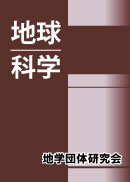All issues

Volume 46 (1992)
- Issue 6 Pages 369-
- Issue 5 Pages 309-
- Issue 4 Pages 265-
- Issue 3 Pages 185-
- Issue 2 Pages 97-
- Issue 1 Pages 1-
Volume 46, Issue 5
Displaying 1-5 of 5 articles from this issue
- |<
- <
- 1
- >
- >|
-
modal analysis and its regional comparisonToshio KusunokiArticle type: Article
1992 Volume 46 Issue 5 Pages 309-324
Published: September 25, 1992
Released on J-STAGE: June 06, 2017
JOURNAL OPEN ACCESSThe sandstones from a large area (the Tamba Belt, the Ultra-Tamba Zone, the Maizuru Belt and the Akiyoshi Belt) in the Inner Zone of Southwest Japan were analysed on the modal compositions of major minerals. Based on the petrographical features and detrital modes, the Permian-Jurassic sandstones are classified into three distinctive groups, that is, lithic, arkosic and quartz-rich arkosic sandstones. The lower to middle Permian sandstones are lithic and the upper Permian sandstones are arkosic. Both of them generally include felsic volcanogenic fragments. Sedimentary environment of the Permian sandstones is assigned to deep sea floor. The Triassic sandstones are lithic, including acidic to intermediate igneous rock fragments. They are derived from a evolved and matured magmatic (continental) arc provenance. The Jurassic sandstones of the Tamba Belt change from lithic to quartz-rich arkosic through time. At the same time, their paleocurrents are changed from south-southwestward into north-northeastward. The detritus of the lower to middle Jurassic sandstones (Type II suite) are derived from a evolved and matured continental arc provenance. On the other hand, the detritus of the upper Jurassic sandstones (Type I suite) are derived from a dissected continental arc provenance. The Relationship deduced from multivariate analyses on the modal composition may reflect similarities of the depositional setting and geological provenance. The dendrograms of the sandstones made by cluster analysis, for example the phylogenetic tree of an animal or a plant, probably show the genetical relationships.View full abstractDownload PDF (1681K) -
part 1; Volcanic rocks of Torikabuto VolcanoSatoshi IgarashiArticle type: Article
1992 Volume 46 Issue 5 Pages 325-338
Published: September 25, 1992
Released on J-STAGE: June 06, 2017
JOURNAL OPEN ACCESSTorikabuto volcano, an early Pleistocene composite volcano, is located on the upper Nakatsu River in North Fossa Magna. The geologic history of Torikabuto volcano is divided into four stages as follows; The activity of the oldest stage, stage I (Maekura Stage), is characterized by the pyroxene andesite pyroclastic flows and lava flows. The distribution of these flows is limited to Mt. Nunoiwa and its vicinity. The next stage II (Onizawa Stage) is characterized by the large amount of pyroclastic flows. They are composed of the rocks ranging from basic andesite to dacite. The formation of a great deal of lava flows is characteristic of Stage III (Torikabuto Stage). The lavas consist of olivine-pyroxene andesite, quartz-biotite bearing hornblende pyroxene andesite and quartz bearing pyroxene andesite. They contain gabbroic inclusions and sometimes show banded structure. They formed several cones. Only a small quantity of dacitic pyroclastic flows were formed during the last stage IV (Post Torikabuto Stage). Torikabuto volcano is mainly made up of calc-alkaline rocks. Chemically the rocks of Maekura Stage are poor in Na2O, Al2O3, Sr and are rich in K2O, Rb, compared with the rocks of the other stages. The rocks of stage II to III have clear linear correlations on SiO2-oxides variation diagram. On chondrite Leedy-normalized REE pattern daiagram, the rock of stage I shows Eu-depleted anomaly. The rocks of stage I and the gabbroic inclusions plot apart from the trend of the volcanic rocks of stage II to III on Sr/Ca-Ba/Ca diagram. On the same diagram, the gabbroic inclusions seem to be connected with the rocks of stage I . The gabbroic inclusions are likely to have some connections with the rocks of stage I chemically on the other diagrams. The rocks of stage II and III contain plagioclase with reverse zoning and bimodal compositions, suggesting the magma mixing process. The facts mentioned above show that the magma forming the rocks of Maekura Stage is different from the one forming those of Onizawa and Torikabuto Stages. The rocks after Onizawa Stage are formed by mixing between basic andesitic magma and dacitic magma. The gabbroic inclusions are cumlates formed from the already differenciated magma which has a correlation with the volcanic rocks of Maekura Stage.View full abstractDownload PDF (1542K) -
Takeo BambaArticle type: Article
1992 Volume 46 Issue 5 Pages 339-349
Published: September 25, 1992
Released on J-STAGE: June 06, 2017
JOURNAL OPEN ACCESSAs asserted by many students, Economic Geology is one of fields of geoscience. In this paper, characters of both natural and social sciences in economic geology, are discussed. Firstly the research history of ore-genesis is briefly reviewed, lastly crisis related to the prospective life of mineral resources is discussed.View full abstractDownload PDF (2173K) -
Yasushi WatanabeArticle type: Article
1992 Volume 46 Issue 5 Pages 351-354
Published: September 25, 1992
Released on J-STAGE: June 06, 2017
JOURNAL OPEN ACCESSDownload PDF (473K) -
Toshio KawamuraArticle type: Article
1992 Volume 46 Issue 5 Pages 363-365
Published: September 25, 1992
Released on J-STAGE: June 06, 2017
JOURNAL OPEN ACCESSDownload PDF (337K)
- |<
- <
- 1
- >
- >|